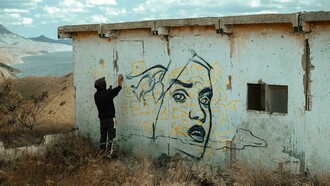When you think of Jelly Babies, what do you think of? Nostalgia? A trip to the dentist? For prolific Milanese artist Mauro Perucchetti, “Jelly Babies are cloned human beings, which, although sweet and cheerful-looking, also carry a sinister ambiguity, a reminder of mankind’s capacity to behave unpleasantly.”
Perucchetti began translating these thoughts into oversized, vibrantly pigmented polyurethane resin sculptures of Jelly Babies in the late nineties. He is the proud creator of various Jelly Baby Families, which come in editions of 8. “The Jelly Baby Family is, in concept, the evolution of a body of work that I created in the late nineties after scientists successfully cloned Dolly the Sheep, theoretically opening the door to cloning human beings,” Perucchetti says. “The thought of cloning was abominable to me. Once humans start to play God, greed, corruption, violence, short-sightedness, and all sorts of other human traits also become involved.”
Cheap labour, expendable soldiers, sex slaves, body parts, companions—the list of horror scenarios that Perucchetti foresaw was long and scary. As debates ensued between religious figures, scientists, and doctors, Perucchetti created a whole body of work in connection to the topic of cloning. This was first exhibited in 2004 at Beaux Arts in Mayfair, London.
The Jelly Babies have attracted more attention than Perucchetti ever imagined. They have been exhibited in several prominent locations around the world, including in front of the Louvre, the Marble Arch, the Wellcome Collection, and the Royal Academy of Arts in London. In late September 2023, his iconic Jelly Baby Family 1.3 went under the hammer at Phillips New Now, New York, selling for $228,600.00, five times the original estimated selling price. No doubt Jelly Baby Family 1.3’s prime position in the Park Avenue shop window prior to the auction helped to attract the attention of many passers-by.
It was always important to Perucchetti to showcase his work in both indoor and outdoor locations, allowing for greater interaction between the public and the sculptures. “I love it when the Jelly Baby Family is exhibited in places like parks or busy city roads. Then they become part of the community, and the approach is more casual. They can really brighten locations with a splash of colour and happiness,” Perucchetti comments. “Having said that, I also love seeing them in more solemn settings like galleries and institutions, where they seem to be more enigmatic.”
Perucchetti is an avid creator of 3-D and textured artwork, and his Jelly Baby Families are a prime example of this. “I think that a painting is an image of something, while a sculpture is something. 3-D work can be touched and viewed from different angles. It interacts with the light in a more vigorous way than a painting ever can, and it casts shadows—sometime even on itself,” Perucchetti remarks. When Perucchetti first began working on the Jelly Babies, resin was the obvious material choice. Its shiny, translucent finish was ideal for the subject matter, and he was already familiar with resin, having worked with it since the age of 15. “Pigmented resin has become one of my signature mediums—one that rewards me for every drop of sweat with truly unique artworks. Resin is a medium that has not been exploited as much as others in art.”
As some of the Jelly Babies became larger in proportion over the years, Perucchetti realized that he needed help turning his vision into reality. After approaching several companies that were working with polyurethane resin, Perucchetti hit a dead end: “I was told that what I wanted to do was unachievable and that any attempts at it would be in the six figures and most probably unsuccessful. This prompted me to go my own way,” Perucchetti explains. “I sold my house to finance the project, and after four years of research and development, I cracked it. I designed my own machines and set up a very unique laboratory.”
Perucchetti’s decision to work with resin may have presented challenges, but the results speak for themselves, and they even earned him critical acclaim from renowned art critic Elspeth Moncrieff: “Resin has an innate instability and is even more difficult to control when foreign materials are embedded within it. Like prehistoric insects captured in the sticky ooze of the amber resin that killed them while preserving them, Perucchetti entraps his objects for all time. His work is totally beguiling. It is high-tech, of our time, bright, clean, and utterly original.”
On numerous occasions, Perucchetti has used the Jelly Babies as a vehicle for important messages. For him, the Jelly Baby Family embodies family union and multiculturalism.
“I detest racism, war, and extreme forms of religion, all of which are aberrations that only succeed in dividing people. It’s not an easy task for small characters out of a bag of sweets appropriated in the spirit of pop art to deliver a serious message like that. But what I love about them is that, like me, they don’t take themselves very seriously, even if the subject matter is serious.”
Perucchetti also produced artwork for the Bill and Melinda Gates Foundation in relation to their “Art of Saving a Life” programme and the topic of vaccinations for children.
“I combined Love Serum, a 10-feet oversized syringe to inoculate the whole world with peace and love, and a Jelly Baby Family. This toy-like assemblage was an attempt to put a smile on children’s faces and eliminate their fear of syringes and needles, while also eliminating the scepticism some parents have about vaccines for the developing world.” Originally installed at the foundation in 2014, the work is a permanent, uplifting fixture that oozes fun and joviality.
Ultimately, Perucchetti’s Jelly Babies beautifully marry the clinical and the sensual, the light-hearted with the serious, the naïve with the complex. The familiarity of the subject matter immediately attracts people’s attention, but the warm glow of the resin in the light makes these sculptures seem almost otherworldly—even if the message they carry is very much of this world.















